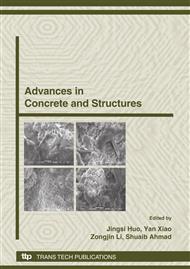p.131
p.137
p.145
p.151
p.157
p.163
p.169
p.175
p.181
Adiabatic Temperature Rise of Incompletely Hydrated Cement Concrete
Abstract:
The temperature rise of concrete during hardening is intimately related to the mix proportion, among which the cement content is a major factor. However, high-strength concrete mixes are often proportioned with low water contents which leads to incomplete hydration of cement contained therein. Hence, the conventional rule of determining concrete temperature rise solely based on the cement content may not yield accurate estimations. An experimental program has been launched to investigate the coupled effects of cement and water contents on the adiabatic temperature rise of concrete. Eighteen concrete mixes were tested with a newly developed semi-adiabatic curing test method and their adiabatic temperature rise obtained by applying heat loss compensation to the test results. The results revealed that, when the water/cement ratio is lower than 0.36, both cement and water contents have effects on the adiabatic temperature rise of concrete. Prediction formula and design chart of adiabatic temperature rise, which are accurate to ±1.3°C compared with the test results, are developed. Furthermore, prediction formula of the degree of hydration of concrete is recommended.
Info:
Periodical:
Pages:
157-162
Citation:
Online since:
October 2008
Authors:
Price:
Сopyright:
© 2009 Trans Tech Publications Ltd. All Rights Reserved
Share:
Citation:


